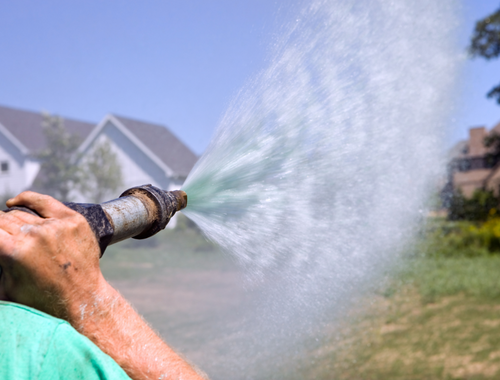Hydomulch is a process where water is used to disperse mulch onto an area. Hydroseed is when water is used to disperse a seed mixture combined with mulch and fertilizer onto an area.

What is Hydromulch?
Definition:
This is when a combined mixture of mainly mulch, and fertilizer is sprayed onto the soil.
Types:
Several types of hydromulch are available to use. These include the following types: 100% Wood Mulch or Cellulose Hydraulic Mulch. There is also 70/30 Hydromulch which is comprised of mainly wood and 30% cellulose. Some High-Performance Mulches are available that are made of either wood fibers or straw. Hydomulch may or may not include seeds, depending on the company involved.
Uses:
Hydromulches are often used along the grass verges of highways and disturbed soils at airports and construction zones of solar and wind farms. It is used to reduce soil erosion.
Advantages:
There are benefits to using hydromulch. It does help fix areas that are disturbed by quickly providing mulch needed for grass and other vegetation to grow in a barren area. It helps bind loose soil together and keeps moisture in for plants to grow. Hydromulch can be used on steep slopes, which is a big advantage over hydroseeds. Hydromulch also decreases rill detachment, which is a benefit to soil quality.
Disadvantages:
Maintaining a site that has been hydromulched can get expensive over time. Water usage may also be higher than traditional methods.

What is Hydroseed?
Definition:
This is when a combination of seed, mulch, and fertilizer is sprayed onto the soil.
Types:
The types of seeds used in a hydroseed mixture include the following: Rye Grass, Fescue, Bermuda Grass, native grasses, and wildflowers.
Uses:
Hydroseeds may be used to rehabilitate disturbed areas and to seed roadside verges. It has been used on wind farms and solar farms. Hydroseeds are also popular for golf courses and even residential areas.
Advantages:
Hydroseeding is a quick way to achieve a thick grass or plant cover. It is much faster to implement compared with traditional approaches to sowing seeds. The hydroseed also keeps more water in, which in turn, causes a thicker and faster germination of the plants.
Disadvantages:
Hydroseed can only be implemented in certain seasons, and it uses a lot of water. It also does not help if the soil is compacted and only works on the surface of the soil. The hydroseed doesn’t improve the soil microbial community and it may not add enough nutrients to a nutrient-poor soil cover. Hydroseeds are best done on flat land to prevent seeds from simply running off the land.
Difference between Hydromulch and Hydroseed?
Definition
Hydromulch is when a slurry of mainly mulch is sprayed onto soil. Hydroseed is when a seed mixture along with mulch and fertilizer is sprayed onto soil.
Types
The main types of hydromulch that are commercially available include Wood Mulch, Cellulose Fiber Mulch, 70/30 Mulch, and High-Performance Mulch along with fertilizer, and sometimes seeds. The types of seeds used in a hydroseed mixture include wildflowers, native grass seeds, and the following grasses: Bermuda, Rye, Fescue, along with mulch and fertilizer.
Topography where it works best
Hydromulch can work on any steep slope or flat surface. Hydroseed is best suited for flat land.
Pros
The benefits of hydromulch are that it retains moisture and binds loose soil, and can be used on steep slopes. Hydroseed is a quick way to get a lush grass or flower cover.
Cons
Hydomulch uses excessive amounts of water and is expensive. Hydroseed cannot be used on steep slopes.
Table comparing Hydromulch and Hydroseed

Summary of Hydromulch Vs. Hydroseed
- Hydromulch and hydroseed can both be used to help prevent soil erosion in disturbed areas.
- With hydromulch, the emphasis is more on the mulching process.
- Hydroseed works best for flat areas where the seeds won’t be easily washed away.
FAQ
What are the disadvantages of hydroseeding?
Hydroseeding cannot be used easily on steep slopes, and it tends to consume a lot of water, which can get costly.
What is the best month to hydroseed?
The end of summer and into early fall is the optimal time to hydroseed.
Is hydroseed as good as sod?
There is debate over whether or not hydroseed is as good as sod. Sod is already established rooted grass that is placed down, but it is much more expensive than hydroseed. In terms of cost, hydroseed may be a better option, but in terms of time, sod may be a better option.
Can you hydroseed on top of existing grass?
Some experts say yes, and others say no. To hydroseed on existing grass, you would first need to cut the grass already present.
What does hydroseed look like after 2 weeks?
After two weeks, you will see patches of grass appear.
Can you hydromulch in fall?
Yes, you can hydromulch in the fall. Fall may be a good time to hydromulch because the extra mulch that is added helps to protect any seeds from harsher conditions that occur in winter.
- Difference Between Rumination and Regurgitation - June 13, 2024
- Difference Between Pyelectasis and Hydronephrosis - June 4, 2024
- Difference Between Cellulitis and Erysipelas - June 1, 2024

